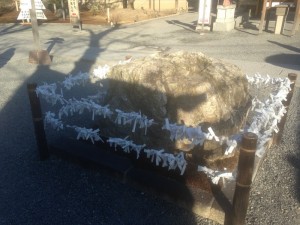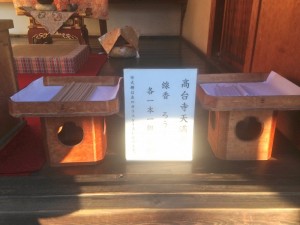
The Tenmangu shrine at the Zen temple of Kodai-ji
Kodai-ji is one of Kyoto’s top tourist attractions, forever associated with Nene (1546-1624), principal wife of supremo Hideyoshi. It’s known for the beauty of its gardens, the wealth of Important Cultural Assets, its connections with tea, but above all for the magical light-ups in spring (cherry blossom) and autumn (maple leaves) when dazzling images are reflected in shallow ponds.
Following the death of her husband, Nene became a nun and was given the honorary title Kodai-in, from which the temple takes its name. It won the patronage of the Tokugawa shogun, whose side Nene took in the dispute with her late husband’s son. As a result the temple has a lavish touch, with sumptuous grounds and use of gold-embossed ‘Kodai-ji lacquer’. Though Nene belonged to the Soto sect, she willed her temple to Sanko Joeki, the Rinzai abbot of Kennin-ji.

Sacred rock with omikuji fortune strips outside Kodai-ji
On a recent visit I was struck by a number of items in the vicinity. One was a sacred rock with omikuji fortune strips but no explanation. Do Chan temples in China venerate rocks, I couldn’t help wondering?
The rock lies near to a Tenmangu Shrine, standing outside the Zen compound but clearly an extension since it has a tiled Buddhist roof. I guess this is another of those shrines not included in the 80,000 figure claimed by Jinja Honcho. A noticeboard at the shrine says that Temma-Tenjin (posthumous name of Sugawara Michizane) was revered by Nene, and that if you walk around the hall three times your wish will be granted and misfortunes disappear. (Sugawara is linked with Kodai-ji’s parent temple Kennin-ji, because while a priest named Enni Ben’en was studying there, he had a vision of Sugawara no Michizane who told him to go to China and study meditation. When he returned, he founded Tofuku-ji.)
Interestingly for a kami shrine, candles and incense were on offer (one stick of each for ¥100). The furnishings too were Buddhist style though with some typical Shinto elements, such as sakaki and salt-saké containers.

At the Tenmangu Shrine, unusually for a kami, candles and incense sticks are on offer
As with other Tenjin shrines, the ema tablets show a preoccupation with passing exams, with ‘Dream’ (as in Ambition) the main theme. At some point in modern times Tibetan-style ‘mani wheels’ were added. These contain the Heart Sutra, and the visitor can earn merit by turning each one as they walk around the hall clockwise. I wonder if this is a unique case of a kami shrine encircled by Buddhist prayer wheels?
Round the corner, on the main ‘Nene thoroughfare’, a subtemple called Gesshin-in houses a rather wonderful small shrine named Ko-Inari Daimyojin. The simplest of affairs, it has a small hokora, stone lanterns with wooden cut-outs of foxes, and a rather cute enmusubi fox pairing that I haven’t come across elsewhere (see below).
Tenjin and Inari are two of the most common kami in Shinto, so it was interesting that they should feature so prominently at a Zen temple. There is no resident priest at Kodai-ji, but it belongs to the Kennin-ji School of Rinzai Zen and priests from the monastery visit daily to carry out rituals, including refreshing the offerings etc at the kami shrines. No doubt these practitioners of ‘no-mind’ are aware of the significance of the kagami (mirror) to which they make obeisance. By removing the ‘ga‘ (ego) from the person reflected in the mirror, the ‘kagami’ becomes ‘kami’!

A portrait of the deified Sugawara no Michizane (Tenjin-sama), sketched perhaps with a Zen touch

Ema at the Tenmangu Shrine have a Dream theme

The Tenmangu ox outside the Zen temple precincts of Kodai-ji

The side of the Tenjin Shrine has a decidedly Buddhist look, with Kodai-ji emblem on the roof tiles and prayer wheels along the side

Inari enmusubi ema – “love, love”

Stone lantern with fox cut-out – an unusual touch
